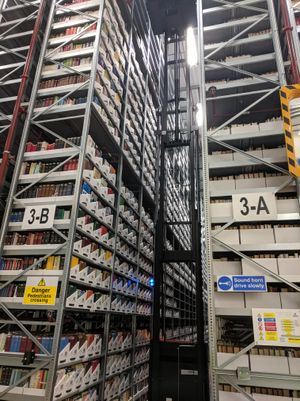Business school writing
I quite like using the word ‘assets’ with reference to library collections. We tend to think of assets in positive terms, as things that are valuable. More of that later.
I was interested to see Rick Anderson remark on the vocabulary used by my colleague Constance Malpas a while ago. This was in the context of a generous note about Constance’s “Cloud-sourcing Research Collections: Managing Print in the Mass-digitized Library Environment.” [pdf].
I confess that I giggle and shudder simultaneously at the thought of referring publicly to books in our collection as “inventory that is increasingly devalued as an institutional asset.” That kind of business-school-flavored language will, not to put too fine a point on it, utterly freak out significant segments of any university faculty, not to mention library staff. // The Scholarly Kitchen
The ‘business’ reference is apt, and I confess that my sense of ‘asset’ in general conversation has indeed been subtly transformed by the narrower acounting sense. For example in the glossary to Robert C Higgins’ Analysis for financial management* we read that an asset is ‘Anything with value in exchange’. And turning, as one does, to Wikipedia, I read an accounting definition: ‘An asset is a resource controlled by the entity as a result of past events and from which future economic benefits are expected to flow to the entity’.
What is relevant here is the idea that assets are things from which you release value. You expect a return. But assets are not ends in themselves. They are means towards creating value. Of course, this is important because assets have associated costs. Managing collections, for example, is not cost-free.
I remember being struck by some sentences about assets in Higgins’ book when I read them first a few years ago:
Some newcomers to finance believe assets are a good thing: the more the better. The reality is just the opposite: Unless a company is about to go out of business, its value is in the income stream it generates, and its assets are simply a necessary means to this end. Indeed, the ideal company would be one that produced income without any assets; then no investment would be required, and returns would be infinite.
Yes, financial metrics lend clarity here, but are not relevent to libraries for whom the question of value is different and less susceptible to measurement.
Library collections and assets
However, it has been interesting see the growing debate about print ‘assets’ in libraries. As the pressure to repurpose space grows and as the print collection releases progressively less value in research and learning, there is a growing interest in managing down print assets. Not unexpectedly, this is in parallel with an emerging interest in securing system-wide preservation of the collective print record. (I provide some examples in the related entries listed below.)
It is clear that research libraries no longer see collections as ends in themselves, or they do not necessarily equate the size of the collection with the value of the library. More is not necessarily better. They also recognise the opportunity costs of managing large print collections.
As we rethink collections, I think we are seeing them more as assets in the sense I have discussed here, as investment is driven by a stronger sense of how they will be used to generate value in research and learning. Of course, some libraries have thought this way for longer: think of how a busy public library manages its collection. And of course, some libraries will continue to have a mission-driven responsibility to collect significant portions of the scholarly record, although we will probably see more collective approaches here.
Anyway, to get a sense of what I mean, Rick Anderson’s presentations might help …
Related entries:
- The service turn
- The collections shift
- Managing down collections
- We’re not going anywhere … Ok, we lied …
* It is always a pleasure to read something that is well written. This is a very nice example of fine technical writing.
Note: Feature picture added and amended for spacing and headings on transition here 29 March 2021.
Picture: I took the feature picture at Cambridge University Library's off-site facility in Ely.




